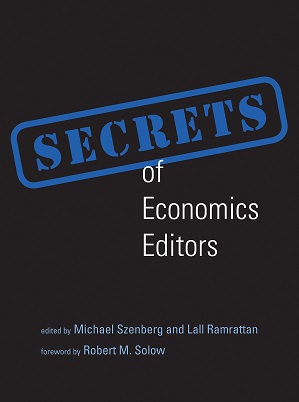Secrets of Economics Editors, Edited by Michael Szenberg and Lall Ramrattan, Cambridge, Mass.: The MIT Press, 2014, 408 pages.
Though economics blogs may be gaining readers, journals remain at the center of the profession. Publication in a top journal is a seal of approval that tells consumers of economics research where to direct their attention. It can bring visibility to a rising star and signal a veteran economist’s continued relevance. Publications and citation counts are still the dominant way of measuring an economist’s productivity for purposes of establishing tenure or promotions. And for future researchers, the profession’s more than 1,000 journals catalog what the profession knew at a point in time.
Therefore, the editors of economics journals wield considerable power. They assign referees and make the final judgment on whether a paper is accepted. They keep referees on schedule and oversee the revision process. In doing all this, they set the tone for the journal and, article by article, help adjudicate scientific advancement itself.
Secrets of Economics Editors explores this vital function. The book features two dozen essays from current and past journal editors, ranging from top general-interest journals to regional and subfield publications. The contributors cover everything from how journals deal with plagiarism and errors — both reasonably rare problems — to competition within the publication industry and the persistent dominance of the highest-ranked journals.
Arguably the most important question about academic publishing is whether journals truly encourage and publish the best research. Opinions on this question differ, but the essays provide some of their most enlightening insights into the value and role of economics journals via anecdotes of the article review process itself, the topic to which the book devotes most of its pages. These stories convey both the subjectivity of the process and how seriously editors treat it.
For example, one of the editor's first and most important tasks is selecting referees, typically one to three per paper. The choice weighs depth and breadth, both of which are important but in different measures based on the aim of the journal. For a paper in a narrow subfield, such as neuroeconomics, it can actually be an asset to select a referee in a different field entirely since, if they are unconvinced by a paper's argument or importance, the median reader is likely to be too. In that sense, "the referee is always right," notes John Pencavel, who edited the generalist Journal of Economic Literature.
At the same time, referees are not immune to bias, and personalities matter a great deal. Campbell Harvey, former editor of the Journal of Finance, recalls keeping detailed records on past referees' timeliness, quality, and even specializations — asset pricing and corporate finance theorists are tougher reviewers, he reports — to aid both his referee-selection process and his interpretation of their reports.
Some editors have experimented with ways of speeding up the profession's notoriously slow response times — authors must sometimes wait a year or longer for a decision — often by finding faster ways of plucking unpromising papers out of the process. Some allow authors to forgo the "revise and resubmit" option in favor of a binary "accept" or "reject," which both promises a faster review and encourages authors to submit a more complete draft. Other editors issue "desk rejections," the practice of flatly denying a paper without consulting referees. Though authors in such instances bemoan the loss of a referee's feedback and are more likely to protest the decision, several of the book's editors maintain that their responsibility is to the journal and not to its aspiring contributors.
Given the diversity across journals in focus and practice, perhaps the only universal fact about editing is that it is not for the faint of heart. The sheer volume of submissions — more than 1,000 per year at some top journals — is both daunting and ensures a very low acceptance rate. R. Preston McAfee, formerly of American Economic Review and Economic Inquiry, estimates having rejected 2,500 papers in his career while accepting only 200. "Fortunately," he writes, "there is some duplication across authors, so I have made only around 1,800 enemies."
Also daunting is the responsibility of balancing decisiveness with an open mind. Authors and editors alike worry that journals "play it safe" by bypassing innovative but risky work in favor of marginal technical accomplishments on an established topic, which can ingrain mainstream thinking. At the same time, some infamous rejections — such as the 1970 "The Market for Lemons" paper that largely won George Akerlof the Nobel Prize — continue to haunt editors. (Perhaps worse, notes McAfee, Akerlof received three confidently smug rejection letters, providing an additional lesson in the wrong way to write them.) Fortunately, most editors report relatively few regrets.
Overall, the book provides outsiders with a rare glimpse into what is arguably still the primary venue of progress in the economics profession. The audience for such seeming minutiae may not be immediately obvious, but as Nobel Prize winner Robert Solow points out in his foreword, it includes anyone who has ever submitted to, been published in, or read an economics journal. In other words, just about the entire profession.




